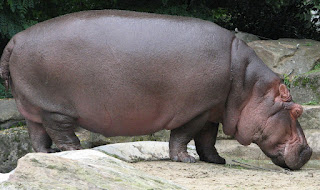Monday, March 16, 2015
Dr Oz on Gut Flora Repair
--- the other 200 posts ---

I am amazed that Dr. Oz and the medical industry can encounter symptoms of dysfunctional gut flora, e.g. constipation, food intolerance, autoimmunity, allergy, that are preceded by antibiotic treatment and not address the compromised species diversity of the gut. The involvement of gut bacteria in immune system function is documented in the biomedical literature. The lasting impact of antibiotics on gut bacteria is known. Then why do Dr. Oz and the rest of the medical industry just recommend probiotics, a half dozen different species of bacteria found in fermenting dairy products (think elephants and giraffes), to repair a decimated gut bacterial community? They seem to be perplexed and ask, "Where is the hippo?"
Generalizations about Gut Bacteria
Each healthy human maintains a subset of a couple of hundred of the couple of thousand different species of bacteria found in humans around the globe. The diverse community in each individual may differ in species, but has approximately the same complement of genes in people sharing the same diet.
- 1-200 different species of bacteria per person
- 1-2000 different species of human gut bacteria
- 1 million different genes among the different bacteria
- Most genes are involved in digesting plant carbohydrates, i.e. soluble fiber: inulin, pectin, fructans, algal sulfated polysaccharides, etc.
- Diet diversity, e.g. the Modern American Diet, reduces the diversity of the gut bacterial community, presumably because the rapid change in foods permits survival of only generalist bacteria that can digest many different foods.
- Simple diets produce gut flora diversity, but only if there is access to diverse bacteria.
- Health may result from diverse gut flora developed from a simplified diet and ample bacterial resources.
- Obesity and other diseases may result from simplified gut flora developed from a changing, complex diet and a sterile environment/isolation.
- Vegan and paleo extremes can lead to healthy gut flora diversity, if the gut bacterial community is permitted to adjust to the diet composition by avoiding rapid changes and providing diverse bacterial sources.
- Meat contains complex polysaccharides, e.g. glycosaminoglycans, such as chondroitin sulfate and heparan sulfate proteoglycans, which are bacterial fodder equivalent to soluble fiber.
- Probiotics are unique bacterial species that do not persist in the gut of adults, but dominate the gut of milk eating babies and stimulate development of the gut and immune system.
- Probiotic bacteria can temporarily provide developmental signals for immune system development that are normally provided by a healthy gut flora.
- Antibiotics cripple gut flora needed for development of the immune system.
- Common medicines have significant antibiotic activity and modify gut flora.
Damage to Gut Flora is Not Repaired by Diet Alone
There is little or no effort being made by the medical industry to develop approaches to repair gut flora damaged by disease, unhealthy diets or medical procedures. This is similar to a surgeon stepping away from removal of a diseased organ without closing the wound. Antibiotics leave a gut flora that will remain permanently damaged without systematic, monitored repair. It might also be suspected that disruption of gut flora by antibiotics and the introduction of large amounts of new foods, such as high fructose corn syrup and vegetable oils may contribute to or cause the modern prominence of obesity. After all, gain or loss of weight changes gut flora, obese individuals have damaged gut flora, and trading gut flora between fat and lean animals, trades weight gain/loss behaviors.
Sources of Bacteria to Repair Damaged Gut Flora
- We must eat new bacteria in order to replace bacterial species lost by antibiotics or unhealthy diets.
- Probiotics -- bacteria that aide gut function, commercially from dairy fermentation
- Fresh vegetables -- bacteria are on the surfaces of plants unless the vegetables are cleaned or cooked
- Fermented foods -- Bacterial growth leading to acid or alcohol production has beed used in the preparation and storage of many foods and provides a rich bacterial resource.
- Environment -- Bacteria are transferred to our hands and face from other people, pets and surfaces, unless hands and the body are continually washed. Sanitizers and frequent washing of hands and surfaces eliminate acquisition of environmental bacteria to repair damaged gut flora. Social isolation and hygiene block repair of gut flora.
- Replacement -- experimental replacement of damaged with healthy gut flora (fecal transplant) has been very effective in curing many diseases without significant risks, but is restricted by the medical industry.
Subscribe to:
Post Comments (Atom)


No comments:
Post a Comment